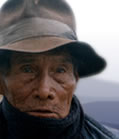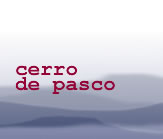THEMES IN THIS
TESTIMONY
Agriculture

Community Activities

Compensation

Conflict

Culture and Customs

Economics

Employment and Income

Environment

Health

History

Identity

Industry

Migration

Spiritual Beliefs

Click on arrows
to find more
testimonies
featuring
these themes
|
|
Sex
|
male
|
|
|
Age
|
22
|
|
|
Occupation
|
footballer/miner
|
|
|
Location
|
Quiulacocha
|
|
|
Date
|
1995
|
|
summary
One of six brothers and sisters, Abel is proud to be part of this hardworking community. Unlike his sister and other young people his age who have left the community in search of work, Abel has stayed behind to help his parents on the land - at least for the present time.
He is a footballer of professional standards. As a result he has had little difficulty in getting contract work in the mines where being a star on the pitch, it seems, is of equal value to working hard underground. But such favouritism is often short-lived; the
work is always temporary and they can get rid of you as quickly as they take you on.
For a young man, he is very sensitive to the changes which have taken place within the community in recent years: fewer resources have affected the traditional animal-rearing livelihoods of the comuneros (registered community members with rights and responsibilities) and many are now forced to seek alternative work (sand extraction, weaving, mining etc). Despite the changes, the community continues to look after its own - healthcare, provision of staple foods etc - and is investing in development small-scale industry, trade etc. And everyone unites to confront Centromin. He laments the impact of the pollution on the environment - social, economic and physical - and openly resents the government and the mining company for ignoring their pleas (- and quietening their protests by bringing in the army).
Abel talks sensitively about the community's legends and traditions. He recognises that there are influences on young people from outside - pop music, fashion etc - but he and his peers are still committed to following the traditional way of life. He is aware that when he gets married, he may have to revise his intention to stay on the land. In the meantime, however, he is fully behind the community’s endeavours and urges everyone – and the young people in particular - to do their bit for the betterment of the community. He ends with an open invitation - to the listener up the President of Peru - to visit Quiulacocha and enjoy Quiulacochan hospitality.
detailed breakdown
|
You will need a password from Panos to view the full
transcript of the interview. To apply for a password, click here.
Once you have a password, click here to go to the beginning
of the transcript. You can also click on any section of the
breakdown of content below and go straight to the
corresponding part of the transcript.
|
| Section 1 |
His family structure: his parents keep some livestock and do some trading, one of his sisters is living in Lima.
|
| Section 2 |
Lack of economic opportunities forces many young people, including his brothers and sisters, to migrate for work elsewhere. He says that 40% of the community work in the mines.
Migration - his views on this. Livestock isn’t enough to support families.
|
| Section 3 |
Description of life as a footballer - mines offer work in return for him being part of the team. Hopes to play for his country but says preference is given to footballers who come from Lima. |
| Section 4 |
“…Centromin has given compensation in the form of 30 contracts. So in this way, sometimes there’s work, other times no.”
Decline in local economy (based on livestock) because of polluted pastures and therefore people have had to start trading and moving from the area.
Talks about the cultivation of maca (a kind of tuber) as a complement to livestock rearing. Economic opportunities in community: people rear guinea pigs and some go to work extracting sand in Sacra. Also a small textile business, a bakery, (which is part of the cooperative) and a dressmaking workshop.
|
| Section 5 |
Talks about support given by community to those in difficulty; poor people and widows. He says there are approx. 180 comuneros in Quiulacocha. He says he thinks there are a total of 18 miners in the community.
|
| Section 6 |
Organisational structure of community – cooperative and decision-making mechanisms (communal assemblies).
Cooperative dairy – could make more money if more publicised.
Vaso de Leche (literally, Glass of Milk: welfare organisation aiming to ensure children receive milk daily) organisation and the participation of women in the community.
|
| Section 7 |
Relationships with other communities – come together to confront Centromin because they don’t take any notice of one village [acting alone].
Mainly join together with Yurahuanca.
Other mining companies around here. Pollution of rivers and lakes.
|
| Section 8 |
Pollution - effects on local livelihoods - fishing, farming etc. Main pollutant is sulphur.
|
| Section 9-10 |
Direct effects of pollution – contaminated air, fields, rivers and lakes, drinking water, people’s health.
Action taken by community against pollution. Some compensation but also retaliation - army brought in to put down demonstrations.
His views on the gringos (North Americans who ran/owned the mines).
Legend of the Quiulacocha bull in the lake. Legends and traditions.
|
| Section 11 |
Young people retain customs despite influences from outside. He doesn’t speak Quecha, not his parents’ fault but because Spanish has been imposed and is spoken “all over the world”.
|
| Section 12 |
Happy to stay here now helping his parents but things might change when he is married and has to find work to support a family.
Future of Quiulacocha - he is optimistic. If they can get the necessary support, they’ll continue to move ahead. Views on community relocating.
|
| Section 12-13 |
He ends the interview by requesting that mine company officials visit Quiulacocha to talk with the community. He would also like the President of Peru to visit and see for himself that this community exists. |
|


